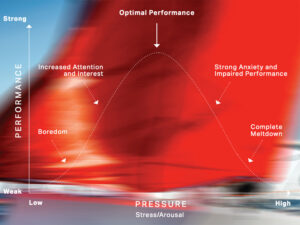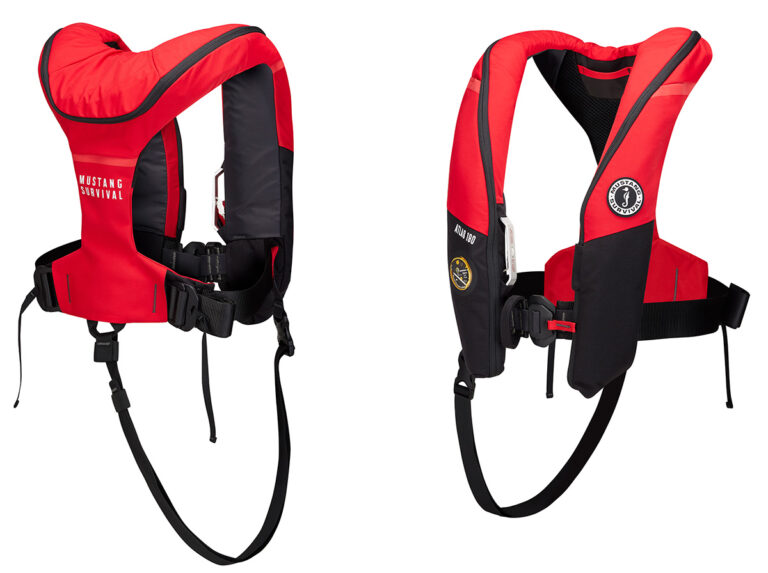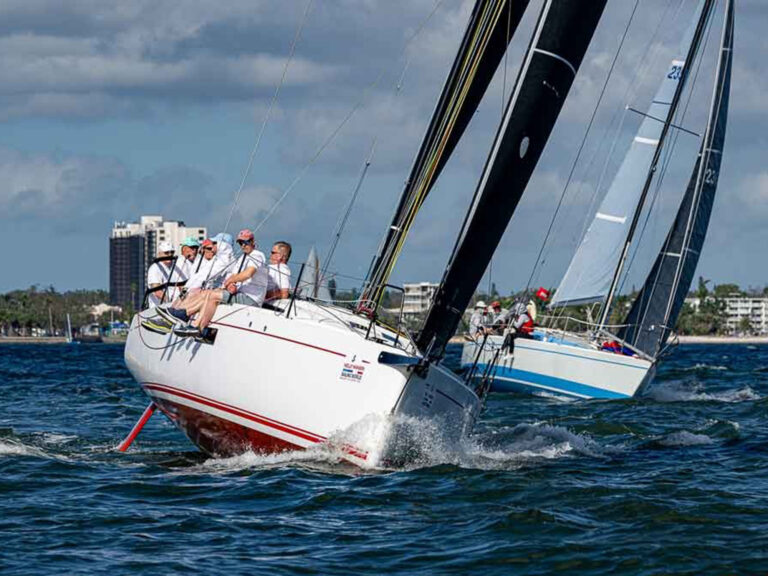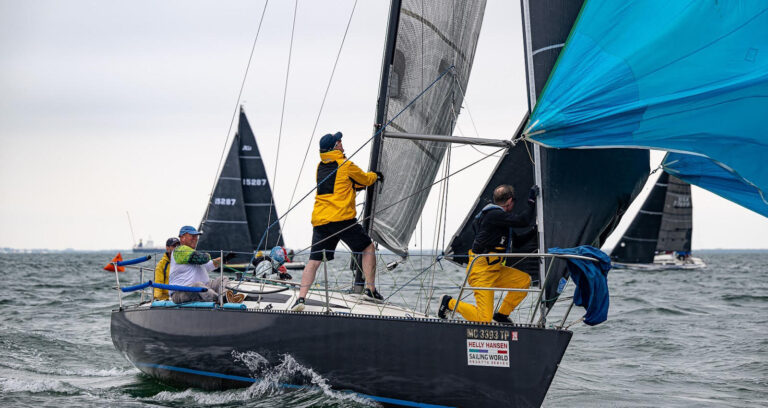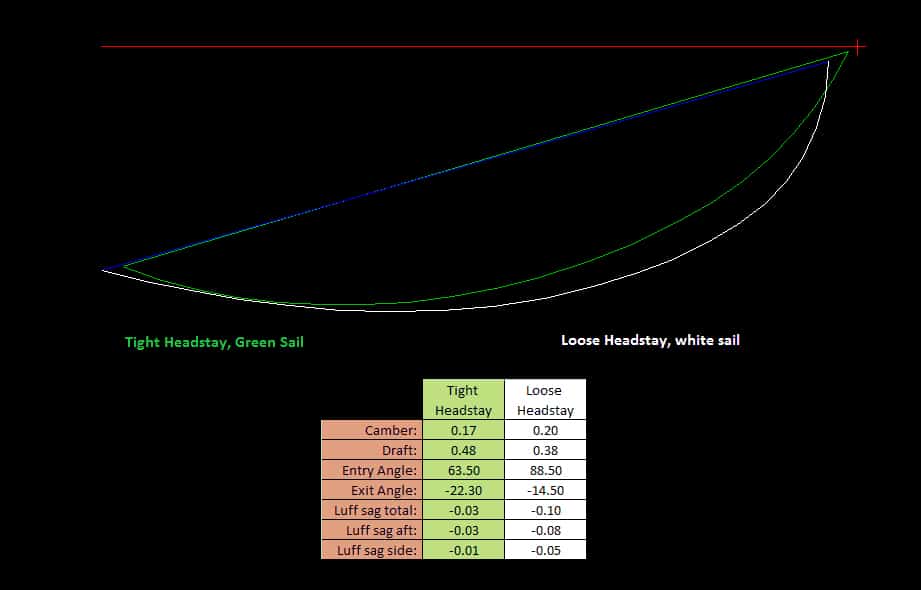
sag-analysis
Because there’s no genoa on a college dinghy, catamaran, or Thistle, I hadn’t focused on the importance of forestay tension until I got into the J/24. I now know it’s critical to making boats with larger headsails go fast, especially in lighter winds. In the most basic terms, we sag the forestay to put power into the sail, and we tighten it to de-power. But why does it work? How do we adjust it? And how do we know that we have the optimum sag?
To understand the effects of forestay tension, it helps to examine how shape is designed into sails. Sailmakers build shape into sails in two ways: broad seam and luff curve. Broad seaming creates shape throughout the sail. Picture a crosscut sail (one with horizontal panels) where, at each seam, one panel edge is straight and the other is in an arc. Join the seams, and the extra material in the middle allows shape into the sail. For a radial sail, the geometry is more complex, but the concept is the same: Building sails with more material in the middle creates a three-dimensional shape when the sail is hoisted.
To add shape with luff curve, the sailmaker cuts an arc of material out of the genoa luff. If the forestay sag matches the luff curve exactly, it doesn’t make the sail deeper or flatter, and all the shape comes from the broad seam. Sagging the forestay beyond the luff curve pushes more material into the sail, making the front of the sail deeper, moving the draft forward, and changing the entry angle. A tight forestay pulls material out and flattens the front of the sail, which effectively moves the max draft aft and creates a finer entry angle.
The subtleties of broad seaming and luff curve are a large part of the science, art, and magic of sail design and tuning. Since broad-seam shape is built in, there’s not much we can do with our tuning or trim to change it. But controlling the power of the sail by artfully adjusting headstay sag is an effective tool.
Finding the correct forestay tension starts on land, where we set the shroud tension and position the mast butt. On our J/24, we start with a default shroud setup, tightening the uppers to No. 20 on the Loos gauge, the lowers to No. 15, and leaving “two fingers” of sag on the forestay. (We say “two fingers” because, on the old-style Loos gauge, the tension is so loose that, when we pull to the black line, we can fit two fingers between the gauge and the forestay.) This is surprisingly loose: I can grab the forestay at about my shoulder level and swing it back and forth through about 1 foot to either side of center before it gets taut. Each class and sailmaker have a different method and set of numbers for measuring forestay tension, so read your tuning guide first, do your best to tune your boat, and then ask your sailmaker to jump on board for a sanity check.
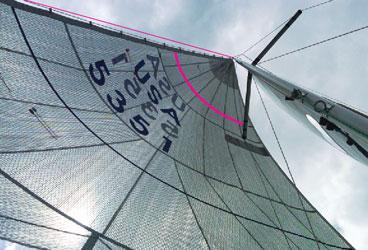
NOT ENOUGH SAG: In light winds on a J/24—these photos were taken in 6 to 8 knots—headstay sag is crucial for developing power in the genoa, which in turn generates pointing ability. This sail, set on a tighter headstay, has less depth, and the position of the maximum draft is further aft on the sail. A boat with a sail set this way will likely struggle to keep pace upwind in light air.
After this initial shroud setup, it’s time to adjust the mast butt and/or chock positions. The J/24 has no chocks, and the mast goes through fixed partners at the deck. By moving the mast step, we can lever the top of the mast fore or aft, changing the forestay tension. To start, we make our best guess at where the mast butt should be. Then, if at the 20/15 shroud setting, the forestay is tighter than two fingers, we move the mast butt aft, which levers the top of the mast forward and loosens the forestay. If the forestay is too loose, we move the mast step forward. In either case, after moving the mast butt, we re-adjust the shroud tension to 20/15. Then we go through the process a few more times until we hone in on 20/15 with two fingers; this is our base setup.
Now it’s time to fine-tune our mast butt setting by sailing with a tuning partner. If we find that our speed is good, but we’re low, we’ll consider moving the mast-butt forward just a bit to slightly tighten the forestay. If we’re high and slow, we’ll move the mast butt a little aft to loosen the forestay. We also look at the front of the jib. If the draft is so far forward as to create what we call a “knuckle forward” look, perhaps we have too much sag. Keep in mind, these changes in mast-butt position are slight—a quarter of an inch in either direction. Once we’ve set the mast butt—and hence the forestay tension—just right, the boat will have good speed and a wide groove. If not, it is worth moving the butt again to find that optimal spot.
After setting the mast butt, we adjust forestay tension for the conditions through changes in shroud tension. Loosening the rig creates forestay sag and adds power to the sail plan; tightening the rig does the opposite. In the J/24, we have six settings representing about a five-knot range each. We adjust both the uppers and lowers. Since they intersect near the top of the mast and pull aft, the uppers mostly control forestay tension. The lowers connect just below the spreaders and also pull aft; they mostly control mast bend.
Mast bend is beyond the scope of this discussion, but it’s important to understand that rig changes don’t just affect the genoa; they affect mast bend and hence mainsail shape. The tighter the lowers relative to the uppers, the straighter the mast will be. A straight mast is like a sagged forestay in that it pushes material into the sail, making the front fuller. Looser lowers allow more mast bend, which pulls material out of the luff for a flatter, de-powered mainsail. The combination of shroud tensions, along with the spreader sweep and mast-butt position, serve to power up the sails—straight mast and sagged forestay—or de-power them—bent mast and tight forestay.
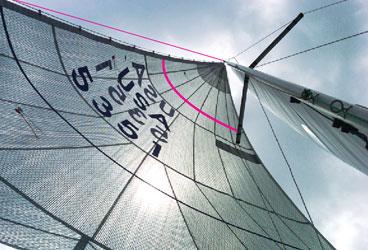
OPTIMUM SAG: A looser headstay helps create a more powerful genoa shape with a deeper entry, a farther forward maximum draft, and a flatter trailing edge. This creates a powerful shape that provides both maximum height and speed in underpowered conditions.
The theory is great to know and following the tuning guide goes a long way, but it is most important to learn what works on the water. We experiment with different settings and make note of what is most effective. We then record these fast settings along with how many turns on our shrouds it takes to move from one wind range to the next. That way, before the start of each race, we can quickly set them and test by briefly sailing upwind. If we are overpowered and find ourselves using the backstay frequently, we go up a range. If we feel starved for power, we loosen the rig. If in doubt, we set up for the lulls because it is faster to struggle overpowered through a puff than to suffer underpowered through a lull.
As with most classes, once the mast-butt position and rig is set in the J/24, the class rules lock us in, and we can no longer adjust them after the prep signal. Fortunately, there are other controls we use to adjust power. When we want to de-power—and achieve a flatter, high-speed shape for smooth water—we tighten the forestay by pulling on the backstay. Flatter sails, with less drag, help us accelerate when we bear off a few degrees to foot to that next header, or when we need to stay bow-out on a competitor. When we want power, we sag the forestay by loosening the backstay and easing the mainsheet. On a J/24, genoa depth is a critical component of good height. A powerful sail setup can help us point on a tight layline or when holding above an annoying lee bow. Adjusting the main and backstay are as important to controlling power through forestay tension as the rig.
The forestay sag discussion doesn’t end here though. When it comes to understanding how to put in or take out the power in your rig, it’s important to continue experimenting. For example, I’m currently exploring what happens when there’s too much sag.
Though paramount in a genoa boat, I am convinced that sag is important in any boat. You, too, should investigate more. With jib or genoa, your goal should be to set up so that the forestay is just right to take advantage of smaller adjustments with the controls. That way, you can control power and speed as you need it.




